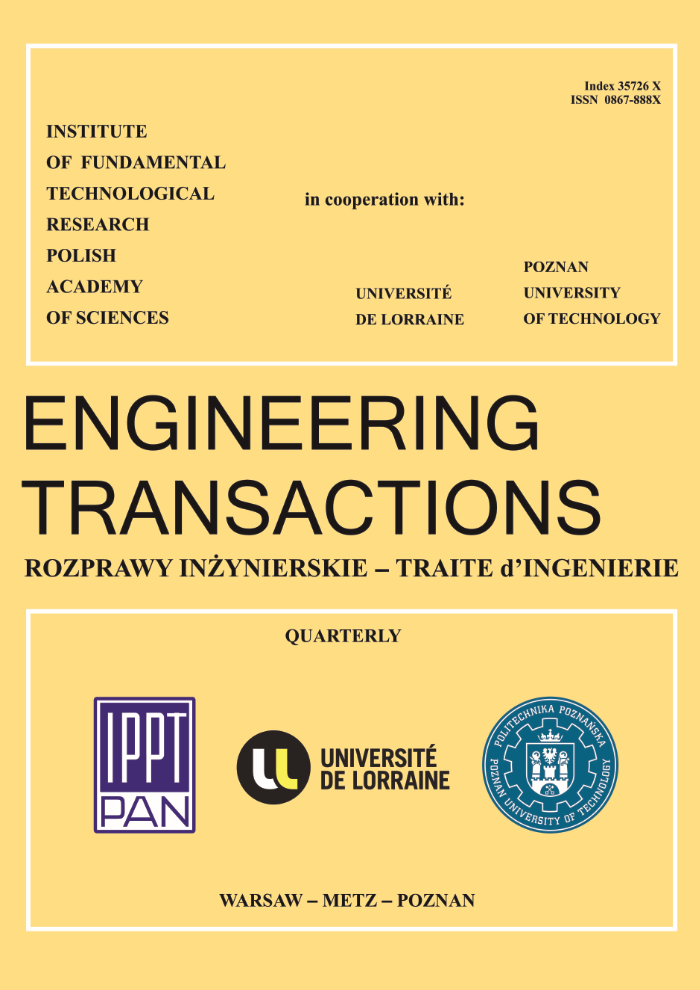Abstract
Poly(lactic acid) (PLA) and poly(butylene adipate/terephthalate) (PBAT) were used for polymer alloys, and the effects of the mixing ratio of PLA and PBAT and the addition of dialkyl peroxide (compatibilizing agent) were examined. The stress-strain curves of PLA/PBAT and PLA/PBAT/dialkyl peroxide specimens were measured using a tensile split Hopkinson bar (Kolsky Bar) method and a universal testing machine. The mixing ratio of PLA and PBAT and the dialkyl peroxide addition affected the shape of the stress-strain curve behavior. Regardless of the strain rate, the yield stress decreased and the elongation at break and strain energy increased with increasing PBAT content when the dialkyl peroxide was used. At high strain rate, the dialkyl peroxide addition increased the elongation at break and the strain energy, and changed the fracture surface to a whitened form that was markedly uneven. This result could explain the improvement in the Izod impact strength.Keywords:
bioplastics, polymer alloys, strain rate effects, tensile split Hopkinson bar, fractographyReferences
1. Fukuda N., Matsubara H., Kitagawa R., The crystallization behaviors and mechanical properties of poly(lactic acid)/poly(butylenes adipate terephthalate) alloys [in Japanese], Proceedings of 59th Symposium on Macromolecules, 5657–5658, 2007.
2. Jiang L., Wolcott M.P., Zhang J., Study of biodegradable polylactide/poly(butylenes adipate-co-terephthalate) blends, Biomacromolecules, 7, 199–207, 2006.
3. Coltelli M.-B., Maggiore I.D., Bertoldo M., Signori F., Bronco S., Ciardelli F., Poly(lactic acid) properties as a consequence of poly(butylene adipate-co-terephthalate) blending and acetyl tributyl citrate plasticization, Journal of Applied Polymer Science, 110, 1250–1262, 2008.
4. Jiang L., Liu B., Zhang J., Properties of poly(lactic acid)/poly(butylene adipate-co-terephthalate)/nanoparticle ternary composites, Ind. Eng. Chem. Res., 48, 7594–7602, 2009.
5. Yuan H., Liu Z., Ren J., Preparation, characterization, and foaming behavior of poly(lactic acid)/poly(butylene adipate-co-butylene terephthalate) blend, Polymer Engineering & Science, 49, 5, 1004–1012, 2009.
6. Signori F., Coltelli M.-B., Bronco S., Thermal degradation of poly(lactic acid) (PLA) and poly (butylenes adipate-co-terephthalate) (PBAT) and their blends upon melt processing, Polymer Degradation and Stability, 94, 1, 74–82, 2009.
7. Ogawa K., Impact tensile characteristics of 6061-T6 aluminum alloy [in Japanese], Journal of Japan Institute of Light Metals, 51, 175–181, 2001.
8. Gray III G.T., Classic split Hopkinson pressure bar testing, ASM Handbook, Vol. 8, Mechanical Testing and Evaluation, 462–476, 2000.
9. Chen W., Song B., Split Hopkinson (Kolsky) Bar: Design, Testing and Applications, Springer, 2010.
10. Nakai K., Yokoyama T., Strain rate dependence of compressive stress-strain loops of several polymers, Journal of Solid Mechanics and Materials Engineering, 2, 4, 557–566, 2008.
11. Nishida M., Ichihara H., Fukuda N., Evaluation of dynamic compressive properties of PLA/PBAT polymer alloys using split Hopkinson pressure bar method, Engineering Transactions, 59, 1, 23–30, 2011.
2. Jiang L., Wolcott M.P., Zhang J., Study of biodegradable polylactide/poly(butylenes adipate-co-terephthalate) blends, Biomacromolecules, 7, 199–207, 2006.
3. Coltelli M.-B., Maggiore I.D., Bertoldo M., Signori F., Bronco S., Ciardelli F., Poly(lactic acid) properties as a consequence of poly(butylene adipate-co-terephthalate) blending and acetyl tributyl citrate plasticization, Journal of Applied Polymer Science, 110, 1250–1262, 2008.
4. Jiang L., Liu B., Zhang J., Properties of poly(lactic acid)/poly(butylene adipate-co-terephthalate)/nanoparticle ternary composites, Ind. Eng. Chem. Res., 48, 7594–7602, 2009.
5. Yuan H., Liu Z., Ren J., Preparation, characterization, and foaming behavior of poly(lactic acid)/poly(butylene adipate-co-butylene terephthalate) blend, Polymer Engineering & Science, 49, 5, 1004–1012, 2009.
6. Signori F., Coltelli M.-B., Bronco S., Thermal degradation of poly(lactic acid) (PLA) and poly (butylenes adipate-co-terephthalate) (PBAT) and their blends upon melt processing, Polymer Degradation and Stability, 94, 1, 74–82, 2009.
7. Ogawa K., Impact tensile characteristics of 6061-T6 aluminum alloy [in Japanese], Journal of Japan Institute of Light Metals, 51, 175–181, 2001.
8. Gray III G.T., Classic split Hopkinson pressure bar testing, ASM Handbook, Vol. 8, Mechanical Testing and Evaluation, 462–476, 2000.
9. Chen W., Song B., Split Hopkinson (Kolsky) Bar: Design, Testing and Applications, Springer, 2010.
10. Nakai K., Yokoyama T., Strain rate dependence of compressive stress-strain loops of several polymers, Journal of Solid Mechanics and Materials Engineering, 2, 4, 557–566, 2008.
11. Nishida M., Ichihara H., Fukuda N., Evaluation of dynamic compressive properties of PLA/PBAT polymer alloys using split Hopkinson pressure bar method, Engineering Transactions, 59, 1, 23–30, 2011.






